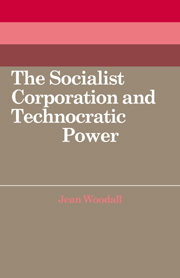 The Socialist Corporation and Technocratic Power
The Socialist Corporation and Technocratic Power Book contents
- Frontmatter
- Contents
- Preface
- List of abbreviations
- 1 Advanced industrialisation, the division of labour and the growth of bureaucratic power
- 2 The building of a socialist economy: social and political limits to growth
- 3 The emergence of a corporate structure in Polish industry, 1958–68
- 4 The emergence of a corporate structure in Polish industry, 1968–80
- 5 The political consequences of industrial integration and concentration: class, Party and management
- 6 The political consequences of industrial integration and concentration: the ‘leading role’ of the PZPR, workforce participation and socio-political reform
- 7 Summary and conclusion
- Postscript: the events of 1980
- Notes
- Bibliography
- Index
4 - The emergence of a corporate structure in Polish industry, 1968–80
Published online by Cambridge University Press: 07 October 2011
- Frontmatter
- Contents
- Preface
- List of abbreviations
- 1 Advanced industrialisation, the division of labour and the growth of bureaucratic power
- 2 The building of a socialist economy: social and political limits to growth
- 3 The emergence of a corporate structure in Polish industry, 1958–68
- 4 The emergence of a corporate structure in Polish industry, 1968–80
- 5 The political consequences of industrial integration and concentration: class, Party and management
- 6 The political consequences of industrial integration and concentration: the ‘leading role’ of the PZPR, workforce participation and socio-political reform
- 7 Summary and conclusion
- Postscript: the events of 1980
- Notes
- Bibliography
- Index
Summary
The climate of economic policy in the late 1960s is most important when trying to understand the reforms in industrial structure. The phrase ‘scientific-technological revolution’ peppered the debate on growth strategy. It was the scientific-technological revolution that would harness the forces of production and enable the Polish economy to travel across the threshold of extensive to intensive development. At the Fifth PZPR Congress in 1968, great emphasis was placed upon raising a flagging growth rate while simultaneously improving individual and social consumption. Annual increases in labour productivity of between 5% and 6% per annum were to be aimed at while simultaneously maintaining conditions of full employment. Two important elements in achieving this would be foreign trade and industrial organisation.
Foreign trade, and more specifically exports, had been a priority ever since the V Plenum of the PZPR Central Committee in 1966. One hundred enterprises all specialising in the production of goods for export (and drawn from 20 industrial associations) were singled out for special treatment, which by 1968 included a much more flexible attitude towards fulfilling plan targets and special arrangements for bonuses and retaining 10% of foreign currency earnings for the purchase of new working capital from abroad. Many of these firms were located in the chemicals and engineering industries where it was felt that an acceleration of investment and output would both encourage exports of these products and reduce the reliance upon imported high technology goods.
- Type
- Chapter
- Information
- The Socialist Corporation and Technocratic PowerThe Polish United Workers' Party, Industrial Organisation and Workforce Control 1958–80, pp. 80 - 117Publisher: Cambridge University PressPrint publication year: 1982


